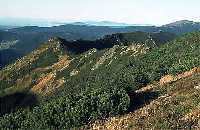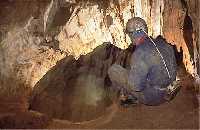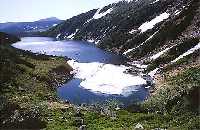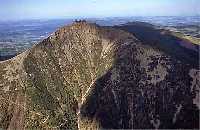Nejvyšší české hory i jejich podhůří jsou jedinečné svou polohou, svou historií a přírodou. Nejvyšší partie hor pokryté tundrou připomínají spíše krajiny Arktidy vzdálené odsud tisíce kilometrů. Níže na svazích hor najdete smrkové a bukové lesy a na loukách rozeseté horské chalupy. V údolích pak kouzelné potoky a řeky a kolem nich rušná i klidná horská střediska.
Velká část Krkonoš je chráněna národním parkem - a to na české i polské straně. Pro svou jedinečnost byly dokonce vyhlášeny biosférickou rezervací Unesco. Přesto najdete v horách i v podhůří mnoho příležitostí pro aktivní dovolenou. Od jara do podzimu si můžete vybrat nepočítaně značených cest pro pěší turisty i cyklisty. V zimě pak stovky kilometrů upravených tras pro běžkaře či řadu sjezdových tratí.
V horách i ve střediscích pod horami je vždy co vidět a co okusit.
KRKONOŠE - HORY ZÁŽITKŮ!
Search for: |
General | Geography | History | Nature- | Climate, weather | Nature conservation | Geology, geomorphology | Flora | Fauna | Tourism- | Tourist Information | Tourism | Outdoor sports | Sights | Celebrities- | Artists | Entrepreneurs | Sportsmen
About the region(found: 11 out of 95 records in category: About the region) The major part of the Polish Giant Mountains and the whole main ridge from Harrachov to the Sněžka mountain consists of granite. In the Palaeozoic era, fervent granite magma insinuated into surrounding crystalline stale and formed a granite massif of up to 5 km thickness. Where the granite magma met carbon rocks the Giant Mountain's ore beds originated. (Obří důl, Svatý Petr, Malá Úpa). Crystalline slate (gneiss, mica schist, phylite,quartzite) is the most common rock in the Giant Mountains. It appeared in the Palaeozoic era some 500 million years ago. Enormous pressures and extreme temperatures re-melted original layers of sea sediments as well as volcanic lava into new rocks. Layered structure is typical for many kinds of crystalline slate. In the mass of crystalline slate there appear insertions and lens of crystalline calcite and dolomites. These are mined at several places of the Giant Mountains (Černý Důl, Horní Lánov, Suchý důl, in the past also Strážné). After polishing they are used for facing (marble), for the production of lime etc. Small caves also appear in the calcite of the Giant Mountains. In the Giant Mountains there are more than twenty small caves, mostly at the East and South rim. They were formed in the past by flowing underground water in calcite layers. Many of them have no natural entry from the surface - they were discovered during calcite mining in quarries. Some have been probably waiting to be discovered until nowadays. During the ice ages of Quarternary Era several glacial tongues appeared in the Giant Mountains. Isolated tower rocks called „tor“ are typical for the peak altitudes of the Giant Mountains as well as the slopes on the Polish side of the main ridge. They were formed during Secondary and Tertiary Eras when erosion caused weathering and loss of softer rocks and uncovered blocks of durable granite which were originally hidden deep under the surface. Uncovered granite rocks were then, as typical for granite, chopped mainly by frost into square blocks. These blocks then eroded into present loaf shapes. During ice ages, frost erosion created stone and boulder seas on most of the highest Giant Mountain ridges. Even when standing on the ground, an open-eyed observer can notice almost circular formations of these stones and boulders - polygons. They were not created by any extraterrestrial civilisation but by frost. The highest altitudes of the Giant Mountains serve as spring areas of several creeks and rivers. On their way to the valley they must overcome large superelevations and that is where waterfalls appear. The largest waterfalls can be found on the steep slopes of huge glacial valleys – Labský důl pit, Úpská jáma hole etc. The highest one (149 m) is a waterfall of the Pančava river on the edge of Labský důl pit.. The small Pančava river springs at Pačava peat moor (near the spring of Elbe river), falls down on the cascade of granite boulders to the valley bottom and finally join the river Elbe. Near the waterfall there is a tourist route with two view spots on it. In the surroundings of waterfalls we can find a large number of rare plant and animal species bound to the humid environment. Evorsion is a kind of water erosion, which abrades rocky river-bed with wafted cobble stones and sand like with emery paper. Where the river-bad shape forms vortexes, water abrades circular wells called "giant pots". It is a common formation of the Giant Mountain streams and rivers. |


























